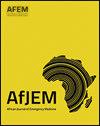Predictors of immediate survival in Emergency Department cardiac arrest in Ethiopia: Insights from a resource-limited setting
IF 1.2
4区 医学
Q3 EMERGENCY MEDICINE
引用次数: 0
Abstract
Background
In-hospital cardiac arrest (IHCA) in Emergency Departments (EDs) remains a leading cause of mortality, particularly in low-resource countries. This study aims to identify the clinical characteristics and predictors of immediate survival among ED cardiac arrest patients in Ethiopian hospitals.
Methods
A retrospective cross-sectional study was conducted among 215 adult patients who experienced IHCA in the EDs of Saint Paul’s Hospital Millennium Medical College and Addis Ababa Burn, Emergency, and Trauma Hospital between January 2022 and December 2023. Logistic regression was used to identify predictors of immediate survival, defined as returns of spontaneous circulation sustained for at least one hour.
Results
Among 215 patients, the mean age was 50.7 years, and 58.6 % were male. The overall immediate survival rate was 46.5 % (n = 100). Independent predictors of survival included male sex (AOR 2.20; 95 % CI 1.06–2.89), respiratory failure as the cause of arrest (AOR 15.04; 95 % CI 2.34–95.13), continuous cardiac monitoring (AOR 4.94; 95 % CI 1.59–15.39), and initial shockable rhythms—ventricular fibrillation (AOR 37.93; 95 % CI 2.20–655.58) or pulseless ventricular tachycardia (AOR 25.64; 95 % CI 5.08–129.47). Admission for sepsis was associated with lower survival (AOR 0.05; 95 % CI 0.01–0.68).
Conclusion
Nearly half of patients with ED cardiac arrest in Ethiopia achieved immediate survival. Continuous monitoring, rapid recognition of shockable rhythms, and prompt management of reversible causes such as respiratory failure improve outcomes, while sepsis remains a predictor of poor survival. Strengthening ED monitoring and resuscitation capacity could improve cardiac arrest outcomes in similar African settings.
埃塞俄比亚急诊科心脏骤停患者即刻存活的预测因素:来自资源有限环境的见解
背景:医院内急诊科的心脏骤停(IHCA)仍然是导致死亡的主要原因,特别是在资源匮乏的国家。本研究旨在确定埃塞俄比亚医院ED心脏骤停患者的临床特征和即时生存预测因素。方法对2022年1月至2023年12月在圣保罗医院千禧医学院和亚的斯亚贝巴烧伤、急诊和创伤医院急诊科经历IHCA的215例成年患者进行回顾性横断面研究。使用逻辑回归来确定即时生存的预测因子,定义为持续至少一小时的自发循环恢复。结果215例患者平均年龄50.7岁,男性占58.6%。总即刻生存率为46.5% (n = 100)。生存的独立预测因素包括男性(AOR 2.20; 95% CI 1.06-2.89),呼吸衰竭作为骤停原因(AOR 15.04; 95% CI 2.34-95.13),持续心脏监测(AOR 4.94; 95% CI 2.59 - 15.39),以及初始休克性心律-室颤(AOR 37.93; 95% CI 2.20 - 655.58)或无脉性室性心动过速(AOR 25.64; 95% CI 5.08-129.47)。因脓毒症入院与较低的生存率相关(AOR 0.05; 95% CI 0.01-0.68)。结论埃塞俄比亚近一半的ED心脏骤停患者立即存活。持续监测,快速识别休克节律,及时处理可逆性原因,如呼吸衰竭,可改善预后,而脓毒症仍然是生存不良的预测指标。加强ED监测和复苏能力可以改善类似非洲环境下的心脏骤停结果。
本文章由计算机程序翻译,如有差异,请以英文原文为准。
求助全文
约1分钟内获得全文
求助全文
来源期刊

African Journal of Emergency Medicine
EMERGENCY MEDICINE-
CiteScore
2.40
自引率
7.70%
发文量
78
审稿时长
85 days
 求助内容:
求助内容: 应助结果提醒方式:
应助结果提醒方式:


